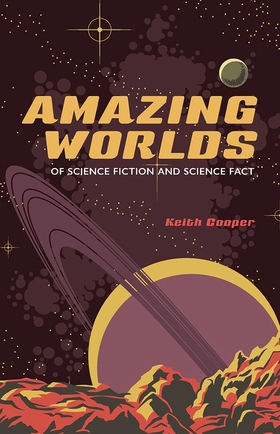Centauri Dreams
Imagining and Planning Interstellar Exploration
TVIW 2016: Homo Stellaris Working Track
Herewith the first of several reports on the recent Tennessee Valley Interstellar Workshop; more next week. It comes from Doug Loss, who was a participant in the Homo Stellaris working track I had hoped to attend before illness changed my plans. An experienced network and IT security administrator, Doug attended and eventually organized The Asimov Seminar from 1977 until the early 2000s, a yearly, four-day-long retreat at a conference center in upstate New York. Isaac Asimov, the noted science fiction author, was the star of the Seminar and its main draw until his death in 1992. Each year the Seminar would explore a different topic having to do with the future of human society, with Seminar attendees assuming roles that would allow them to examine the questions associated with that year’s topic on a personal basis. TVIW is likewise following a highly interactive workshop strategy, as Doug’s report attests. The photos below come from New York photojournalist Joey O’Loughlin, and are used with permission.
By Douglas Loss

The Tennessee Valley Interstellar Workshop took place from February 28 through March 1 in Chattanooga, Tennessee, a very pleasant place to be. On both Monday and Tuesday the mornings were taken up by multiple plenary talks, primarily on technical topics, with most dealing with propulsion possibilities for interstellar flight.
Two notable exceptions were the talks by General Steven Kwast, commander and president of Air University on Maxwell Air Force Base and by Dr. James Schwartz, professor of philosophy at Wichita State University. Both of these talks seemed to engender some “push-back” from various participants.
General Kwast’s talk was titled, “Invited Remarks Concerning America’s Far Future in Deep Space.” The general talked about what it means to have legal authority to enforce behaviors, and how this might apply in interplanetary as well as interstellar societies. His talk was clearly from an American perspective, which seemed to create some tension in some of the participants.
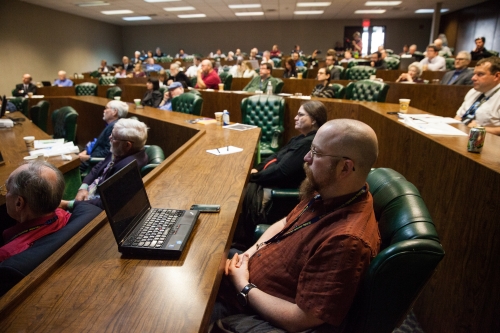
Image: Gathering in Chattanooga, TVIW meets in a plenary session. Science fiction writer Oz Monroe is in the foreground, and Greg and Jim Benford are just visible in the front row. Credit: Joey O’Loughlin.
Dr. Schwartz’s talk was titled, “Conceptual Filters in Space Exploration: Rethinking the Rationale for Planetary Protection.” The questions he posed were all related to the value of keeping extraterrestrial environments pristine, free from exploitation or any use. It is generally assumed that if life is found on an extraterrestrial body, that body should be enjoined from development at least until the life-forms have been studied thoroughly. Dr. Schwartz asked, is life on a body the only reason we should consider enjoining development of that body? Might there be other, non-vital, reasons for doing so? If so, what might these be, and who should decide? The possibility of removing sources of extraterrestrial resources from exploitability for philosophical reasons also created some tension.
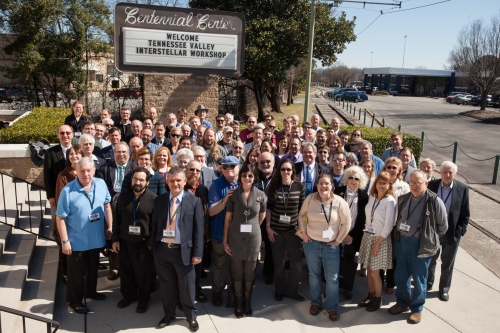
Image: The assembled TVIW 2016 group. Credit: Joey O’Loughlin.
Both of these talks related directly to the Homo Stellaris working track, which was given the task of considering the biological, psychological, and sociological implications of interstellar travel. In our work sessions we made some assumptions to allow us a base to work from. We assumed that we would look at what could and should be done in the next 50-100 years. We further assumed that we were starting from the current technological and sociological baselines.
We asked ourselves what historical analogies might inform our thinking, as a way in which humanity might expand to the stars as a matter of course. The best analogy we thought of was the Polynesian expansion across the Pacific Ocean, where small groups moved from one island to another, stopping to colonize any useful island found and then the population of that island expanding on toward other islands as their island was fully colonized.
We decided that this kind of expansion might be needed in space, since we are not currently able to create a closed biosphere, or even one that will be stable for decades or centuries. The expansion we envisioned would be to habitats gradually further and further from Earth, where the possibility of rescue or large-scale repair/replacement of materials would be less and less possible. As these habitats would be created, we would learn how to improve the biospheres, gradually having them be self-sufficient for very long periods or even indefinitely.
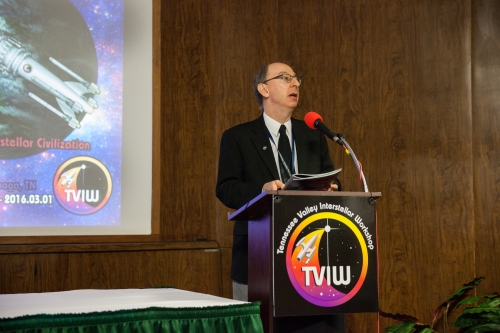
Image: TVIW chairman Les Johnson introducing this year’s workshop. Credit: Joey O’Loughlin.
We also decided that it was important to send one or more FOCAL missions out to roughly 550 AU, to use the solar gravitational lensing technique to directly image extra-solar planets that might be prime targets for interstellar colonization. As humans are primarily visual animals, being able to see the planets would provide a much greater possibility of a positive attempt to travel to them [see Catching Up with FOCAL for background].
Finally, within the 50-100 year timeframe we decided that it should be possible to send a one-way exploration mission to a promising extra-solar planet. This mission would be comprised of roughly 100 participants, in long-term suspended animation (we reviewed the current state of the art and it seemed likely that this could be feasible within the timeframe). At any time, from 5-15 participants would be awake and monitoring the ship; the shifts would be perhaps a year long, with membership overlapping so there would be no large-scale transition from one shift to another.

Image: A quiet moment and a phone call. Interstellar researcher Philip Lubin. Credit: Joey O’Loughlin.
When the ship reached its destination, the participants would set up their habitat, preferably on the planet directly. They would live out their lives exploring the planet and transmitting their discoveries back to Earth. This mission would provide a “proof of concept” for human society, which we hoped would be even more incentive to build and launch a generation ship to colonize the planet. With some luck, the colonization ship would reach the planet before the members of the exploration mission had all died. We did anticipate the exploration mission members would have families to carry on the mission.
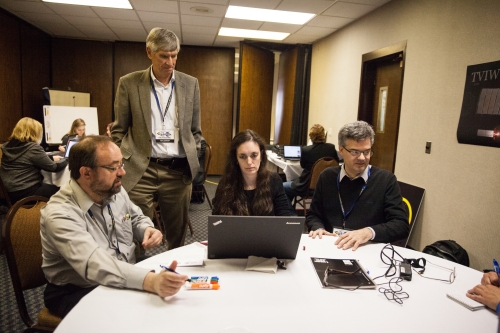
Image: A working track in progress. Marc Millis (left), Jim French (standing), Leigh Boros and Michael LaMontagne. This photo comes from the Worldship track; unfortunately, Joey didn’t have any photos of the Homo Stellaris track. Credit: Joey O’Loughlin.
We didn’t extend our thoughts beyond that period, although we did discuss many of the biological, psychological, and sociological pitfalls that might occur.
We saw a robust interplanetary civilization as a prerequisite to any serious interstellar colonization attempts, as the effort to build and launch such a mission seemed very unlikely to be acceptable to any solely terrestrial group, whether commercial, governmental, religious, academic, or any other type.
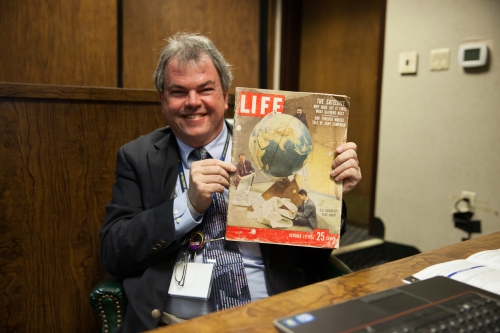
Image: TVIW co-founder Robert Kennedy. Credit: Joey O’Loughlin.
There was little coordination or cross-fertilization among the working tracks, so the other groups (Worldship, Space Solar Power, and Space Mining) were quite likely starting from different assumptions than Homo Stellaris was using. This was unfortunate but probably unavoidable given the short period of time available.
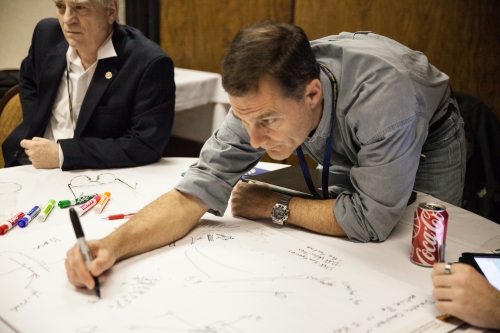
Image: Icarus Interstellar’s Robert Freeland at work. Workshop track sessions were lively and intense. Credit: Joey O’Loughlin.
Overall, the workshop was very enjoyable and provided some valuable discussions on just how interstellar travel might be promoted, developed and substantiated in the real world and the reasonably near future. We look forward to the next Tennessee Valley Interstellar Workshop in 2017!

Making Centauri Dreams Reality, Virtually
I often think about virtual reality and the prospect of immersive experience of distant worlds using data returned by our probes. But what of the state of virtual reality today, a technology that is suddenly the talk of the computer world with the imminent release of the Oculus Rift device? Frank Taylor is just the man to ask. He has worked with computer graphics since the 1970s, starting at the University of Arizona. He worked several years at aerospace companies in support of DoD and NASA including simulation and virtual reality technology in support of astronaut training at NASA JSC. Frank has also been a successful entrepreneur doing work with Internet and other computer technologies. His most notable recent accomplishment was the completion of one orbit of the Earth at 0 MSL – he and his wife left in 2009 and sailed around the world arriving back in the US in 2015. Frank is the publisher of Google Earth Blog since 2005. Have a look now at the surprisingly wide possibilities already opening up for VR.
by Frank Taylor

For most of us reading Centauri Dreams, we have lived out our lives dreaming about travel to other stars and planets. Many of us have tried to satisfy our dreams vicariously by enabling the various unmanned missions to our non-terrestrial, solar system-based planets, Sun, moons, asteroids, and comets. Last summer, we were all captivated by watching the fly-by of our most distant planetary-like neighbor Pluto and its moon Charon.
In addition, we have over four centuries of both terrestrial and space-based telescopic observations to thank for our measured observations of both local and interstellar astronomical objects as far as our science has allowed. But, our hopes and plans of visiting other stars and planets for more direct observation has continued to elude us. For well known reasons documented here on Centauri Dreams.
Image: My friend Frank Taylor, photographed here on the Indian Ocean island of Reunion during his recent circumnavigation, which is fully documented (and with spectacular photography) on his Tahina Expedition site.
Computer Simulations of Space
As a career computer graphics scientist, I have been fortunate to simulate space-based operations for training astronauts, simulate remote tele-robotic space operations, and create animations depicting some of our in-orbit and planetary missions. I have also thoroughly documented the use of Google Earth for enumerable Earth depictions as well as involved in developing its use for other planets and moons in our solar system. I’ve published the Google Earth Blog since 2005 with almost daily news and stories about that program and its uses.
Going back to 1991, while working under contract with NASA JSC, I discovered a demonstration program on a Silicon Graphics workstation that was developed by an engineer named Erik Lindholm. It depicted a 3D simulation of the known local star systems, our entire solar system, and even had a few science fiction objects like Ring World around another star. The amazing thing was that you could travel between objects at speeds far exceeding known physics. Measurements were at multiples of C (speed of light). I was entranced by this experience of finally traveling to another star, and it wasn’t necessary to wait an unreasonable amount of real time to get there. For years afterwards, I wondered why someone had not ported the application to a wider audience (possibly less than 500 people saw that early one) – especially with the rapidly improving computer graphics capabilities of the typical desktop computer that decade.
In the 1990s, there were numerous planetarium applications that let you simulate the night sky, and some even let you visit other planets. But, it wasn’t until early 2001 that a real interstellar travel 3D simulator became popular. A program many of you may have heard of called Celestia (Wikipedia) was released and available for free. It mostly focused on the solar system, but also modeled a fair number of known star positions and compositions, and even allowed you to see an approximation of our galaxy and visit 3D versions of neighboring galaxies (but, not individual stars and planets).
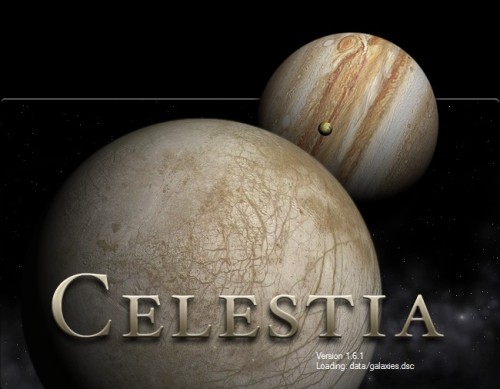
Image: Screenshot of Celestia loading data Version 1.6.1.
The developers ported Celestia to many operating systems (Windows, Mac, Linux, and even Amiga OS). An active community of fans contributed enhanced quality textures for planet surfaces, contributed ideas for educational tours, produced or converted 3D models of spacecraft (both real, design concepts, and fictional), and more.
For 10 years, Celestia was active. But, the developers stopped work by 2011. Celestia and community content is still available. Even if you have an older desktop or laptop, Celestia is likely to run well. Download Celestia here, and see the community content here. The caveat is that the graphics are based on older (circa 2000) generation products, and computer graphics cards have leaped ahead in quality in the last 15 years.
Current Generation Space Simulations
Recently, I was lamenting the lack of progress since Celestia, and discovered a link to an amazing Windows-based program called Space Engine (Wikipedia). This program is sure to make almost any astronomer, or Centauri Dreams fan, exclaim in awe and wonder for the opportunity to visualize and virtually experience interstellar destinations with almost artistic quality. Developed by a single programmer in Russia, whose name is Vladimir Romanyuk, with input from Russian astronomers and international scientists and fans, this program is amazing. In his own words Space Engine is described as:
“A free space simulation program that lets you explore the universe in three dimensions, from planet Earth to the most distant galaxies. Areas of the known universe are represented using actual astronomical data, while regions uncharted by astronomy are generated procedurally. Millions of galaxies, trillions of stars, countless planets – all available for exploration. You can land any planet, moon or asteroid and watch alien landscapes and celestial phenomena. You can even pilot starships and atmospheric shuttles.”
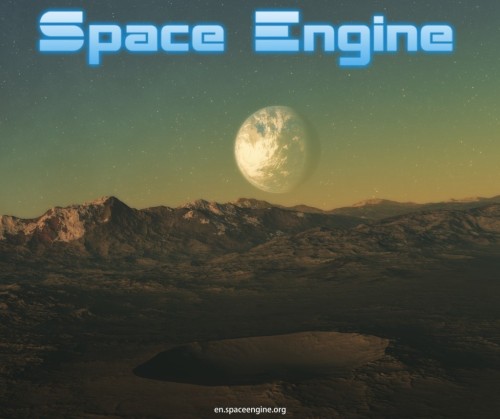
Image: Screenshot of Space Engine loading Version 0.9.7.4 showing moon terrain and atmosphere in orbit around oceanic planet.
Space Engine uses publicly available astronomical databases to represent the known stars and planets. Then he goes on to generate a suitable composition of remaining stars, star clusters, and nebulae for galaxies. Next, the program extrapolates planetary systems based on best guesses for physical compositions using orbital distances, star temperatures and types, and other factors. Planet classifications include gas giants, ringed worlds, desert planets, oceanic, ice, and more. Then he procedurally generates 3D terrain, and – when physically viable – water bodies, craters, mountains, canyons, volcanoes, and other terrain. The application then colorizes and adds textures to make the surfaces look realistic. Atmospheres are rendered, when present, including colorization based on physical composition and star colors. Space Engine even calculates whether life could be present on planets with the right characteristics. Also, a great deal of effort has been put into rendering black holes and accretion disks.
Here is a YouTube video by a fan reviewing an older version of Space Engine (by ObsidianAnt):
Video: A high resolution video showing samples of views in Space Engine with review commentary. Credit: YouTube, ObsidianAnt.
In attempt to make the program have a game-like feel, you can also add 3D space ships (including interstellar traveling ships) and actually fly them using a variety of supported controlling devices. Personally, I have plenty of fun just exploring stars and planetary systems without the spacecraft simulations. But, some readers here might have fun putting their favorite interstellar spacecraft designs into Space Engine.
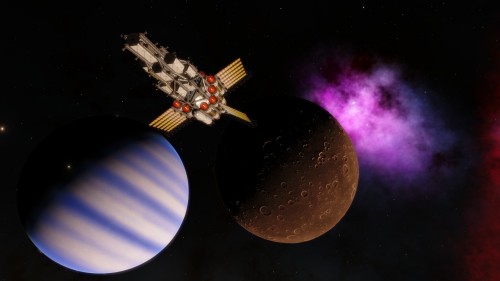
Image: Screenshot from Space Engine showing spacecraft in front of moon and gas giant with nebula in background.
Space Engine is available for free for Windows only right now, but you have to own (or have access) to a relatively recent desktop with recent high-end video card, or a high-end gaming laptop, to run this powerful program well. Recommended requirements are listed on the bottom of the home page for Space Engine. If you want to try it, the latest version can be found (in the forums) here. Vladimir is asking for donations to help fund further development and ports to Mac and Linux. I encourage those who enjoy the program to make a donation.
Space Engine attempts to be a mirror of the real universe as we know it. With the main exception being that travel times are greatly reduced. Would you believe there is yet another category getting even more development attention involving virtual interstellar travel?
Computer Games with Space Simulations
It is widely known that computer graphics’ rapid technological advancement in the past 40+ years was not solely due to scientific application pursuits. An even bigger factor has been the advancement and popularity of computer games. The same thing is happening to space-based simulations. There is an acceleration of interest in space-based games that is advancing the technology of space simulations. While Space Engine has been developing admirably during the past two years with a sole programmer of talented skills, a number of space games have been developed with modern gaming development budgets in the millions of dollars, and requiring dozens of game software engineers, artists, writers, physics modeling, simulation software, database engineers, and a business marketing budget equal to half the overall budget or more.
Some of these games involve interstellar travel and exploration and science fiction themes involving mostly commerce, and the inevitable gaming need of military action to protect interests. The typical gamer takes on jobs of space mining to build a fortune to acquire bigger and better space ships. Then they graduate to military ships and space battles ensue on a massive scale. For example, one massively online role playing game called Eve Online (Wikipedia) hosted last October a large scale space ship battle involving the loss of 1,165 ships (which equated to in monetary conversion to US $13,000) with 1600 gamers participating ( story here by Michael Bonnet, PC Gamer).
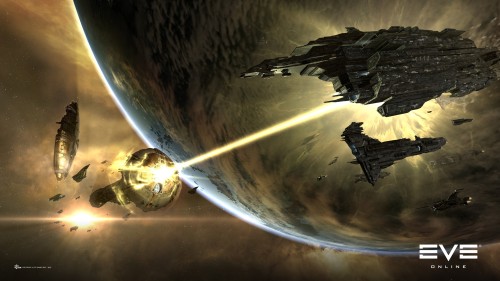
Image: Image of Eve Online orbital battle scene by CCP Games.
My interest lies in games that generate realistic visualizations of interstellar systems using spacecraft that we might build ourselves for exploration (if we can overcome the physics to get over the distance factors). The best space game simulation example I have seen is a game called Elite Dangerous (Wikipedia) by Frontier Developments based in Cambridge, UK. Frontier have created not only very realistic renderings of space and spacecraft, but have also added highly versatile surface recon vehicles (SRVs) that you can drive on the surface of planetary bodies (available in their latest season called Horizons).

Image: Image of Elite Dangerous – program developed by Frontier Developments Plc.
Elite Dangerous star systems and planets are quite well rendered in many ways similar to Space Engine. The graphics and lighting are astonishingly real, as is the physics of the simulations. Of course, because it is a game, situations can involve space battles with competing factions for space-based mining and other commercial operations. But, you can also just explore on your own as demonstrated in this YouTube video which shows a tour of our Solar System:
Video: A high resolution video showing a tour of a future version of our solar system from the game Elite Dangerous: Horizons. Credit: YouTube, ObsidianAnt.
Some of our planets have changed a bit due to human influences over the next thousand years of space development. You will note that fine simulation details such as the rendering of instrumentation on the pilot stations with working indicators of thrust, gravity, attitude, fuel, scanning of terrain when landing, and other ship and object conditions. Ships can be controlled with a number controllers such as those used for flight simulation, game controllers, or even mouse and keyboard.
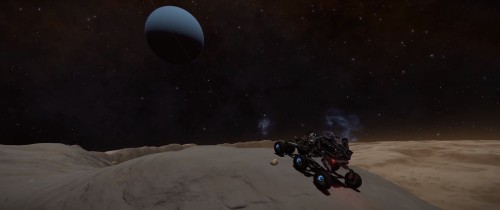
Image: Screenshot of rover on moon near planet in Elite Dangerous from YouTube video above by ObsidiantAnt.
As you can see, the budget of big games has resulted in an astonishing amount of simulation detail. You also may note that the video above was produced by the same person who created the video I shared for Space Engine. People who like the idea of interstellar travel gravitate their way to these similar space simulations.
The New Age of Virtual Reality
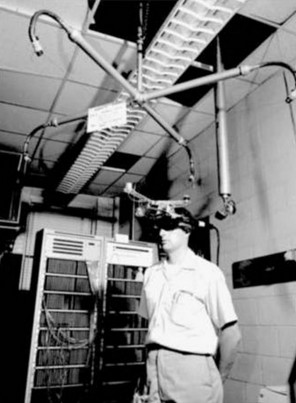
A major new influence of computer graphics is excitement surrounding the recent introduction of consumerized virtual reality technology. Virtual reality usually refers to immersive multimedia using computer simulation, accomplished through a head mounted display system representing stereoscopic 3D, or other multimedia, display, renderings and stereo audio. The idea of virtual reality technology and its development go back nearly as far back as the first computer graphics. The first immersive display system was built by Ivan Sutherland in 1968. It involved a heavy suspended helmet system with an early development of miniaturized cathode ray tube displays. The system became known as “Sword of Damocles”.
Image: Photograph of first VR system designed by Ivan Sutherland in 1968. The system became known as “Sword of Damocles”. A head mounted three dimensional display”, Ivan Sutherland, 1968.
In the late 1980s excitement about virtual reality reached beyond the purview of computer graphics researchers. This happened when advances in 3D graphics machines, display systems, 3D positioning devices, and hand-tracking devices began enabling interaction and a sense of immersion.
Of personal interest was that NASA was quite involved in research in VR in the 1980s. NASA Ames Research Center formed the Virtual Environment Workstation (VIEW) lab and was headed by Scott Fisher. In the early 80s, I worked at NASA JSC on the space shuttle simulator computer graphics used for training the astronauts. In the late 1980s I was working with engineers in a robotics simulation lab at NASA Johnson Space Center and one project was a VR helmet system used initially for research in training astronauts for the Manned Maneuvering Unit (MMU) for space walks. Later (early 90s) this system was used for tele-robotic simulations I helped develop to explore controlling the robotic arms on the space station (which was still being designed at the time).
Science fiction books fed fuel to the VR fire, when William Gibson’s book Neuromancer (1984) introduced the term “cyberspace” in the early 80s. Later, Neal Stephenson published Snow Crash (1992) which popularized a concept of a virtual reality rendered universe, which he called the “Metaverse”, which humans could visit and be represented through an avatar in a 3D world with shared defined places.
Hype about VR became widespread in the technology industry first in the late 80s. Then gaming companies in the early 90s announced VR systems that could be used in the popular video arcades. A movie called The Lawnmower Man (1992, Wikipedia) helped introduce the concept of VR to an even wider audience. Probably the most popularized science fiction concept of virtual reality was introduced in the late 80s in the form of Star Trek: The Next Generation (TV series, 1987, Wikipedia) with the “holodeck”. Of course, the holodeck is still the ultimate dream of a lot of VR enthusiasts.
Unfortunately, the capabilities used by researchers involved in VR in the 80s and 90s used very expensive computer graphics workstations and display devices. And, the displays were very crude at about 320×240 resolution at best. It was not yet possible to create cost effective, or realistic-looking systems at that time. The resulting game VR systems were crude and underwhelming when they came to market. Companies investing in the technology lost a lot of money and the concept’s popularity waned. I actually left NASA in 1992 intending to form a VR company, but my business planning fortunately revealed the impending dilemma and I instead started an Internet company. The impact of the burst of VR hype in that period of time, reduced interest in investment of consumer VR for the next 20 years. Far longer than I, or many other people, would have believed.
In 2012, an enterprising 19-year-old VR fan by the name of Palmer Luckey introduced the concept of building a new head mounted display (HMD) system using the now much more advanced computer graphics capabilities of desktop computers. Advances in display systems for mobile phones made possible much higher resolution displays for VR in a more lightweight HMD.
Palmer Luckey’s idea was an example of impeccable timing. He formed a company called Oculus to build his first system to be called the Oculus Rift. Within months, his company introduced the idea of raising funding through the crowdfunding site Kickstarter. He already had a large following in the gaming community because of an association with the most revered computer graphics gaming guru John Carmack. His goal was to raise $250,000. The concept was so popular that the goal was reached within four hours, and ended up raising nearly 2.5 million dollars instead. Although most of the contributors were gamers, the applications of VR reach a far wider range. Possibly the largest is entertainment as 360 filming has become practical and is very impressive.
By the end of 2013, Oculus had raised $75 million dollars in investment, headed by the leading technology investment broker Andreesen Horowitz. In March of 2014, Mark Zuckerberg announced on Facebook that they would be acquiring Oculus for $2 billion. Needless to say, this greatly raised attention to VR.
Even with the resulting flood of money, it would take two years to prepare the first Oculus Rift for consumer sales. However, Oculus also worked with Samsung to introduce an HMD called GearVR that works with top-end Samsung smartphones as the display device for only $100. It became widely available to consumers in 2015. The first Oculus Rift became available for pre-order in early January 2016. The first units are scheduled for delivery March 28, 2016. The difference between the GearVR and the Rift are greater fidelity and performance of computer graphics, better visual optics and positional tracking, 3D controllers and more versatility with a multi-tasking operating system. A competitor to Oculus from HTC called Vive started pre-orders on February 29, 2016. It has the ability to stand up and move around, and has two 3D hand-controllers for interaction.
Despite the delayed delivery to consumers, Oculus has reportedly shipped 200,000 units of prototype Oculus Rift units worldwide to software developers since early 2014. Numerous software products, in particular games, have introduced support for the Oculus Rift (and other Head Mounted Displays which have since been announced by other companies). And, over $2 billion in addition investments have gone towards the ecosystem of new VR companies in the last two years alone. Top analysts are predicting huge forecasts for adoption, but it’s a little early to say what the reaction will be until the new consumer products are on the shelves and real software ships.

Image: Oculus Rift pre-order entry page January 6, 2016 with photo showing the components in the Oculus Rift package. First deliveries were scheduled for March 28, 2016.
VR in Space Simulations Today
Both Space Engine and Elite Dangerous have support for VR. In Space Engine, you can both gaze in wonder at the beauty of the universe, but also sense the scale and grandeur of nearby planets, moons, nebulae, and stars. While the system works well for Space Engine, the sense of immersion and 3D effects are much more pronounced in Elite Dangerous due to the primary placement being in the pilot seat of the space craft used for exploration. Stereoscopic 3D immersion is much more noticeable for objects in close proximity due to parallax. Hence the views are even more immersive in Elite Dangerous and the simulations of landing on a planet are quite exciting. Needless to say, these space-based experiences are very gratifying to me as a long-time believer in VR, especially with actual VR experience dating back to 1990.
Meanwhile, NASA and aerospace companies have continued to use VR for space simulations throughout the past 20 years. Some of the very same engineers I worked with in the early 90s started a VR Lab at JSC and have been using VR to train astronauts ever since (see article by Erin Carson at Tech Republic).
One of the most talked-about space VR programs is an educational story about the Apollo 11 mission to the moon. You can watch elements from launch to the historic moment when Armstrong steps on the moon. The in-development product has already won awards because of the strong emotional impact it has had on its viewers, and videos and demos are available for viewing in VR. You can watch a 360 video trailer of the Apollo 11 VR produced by Immersive VR Education out of Dublin, Ireland here (if you have cardboard you can watch it in 3D):
The new consumer space simulations software like Space Engine and Elite Dangerous are the closest most of us or going to get today to experiencing the exploring distant interstellar worlds and places. However, it should be noted that the requirements for the new consumer VR HMDs does have even higher system requirements for faster processors, memory, and video cards.
Interstellar researchers and exploration dreamers take note. Your chance for travel to the stars is virtually here.

Protecting Life on the Early Earth
Kappa Ceti is a young star — 400 to 600 million years old — in the constellation Cetus (the Whale). It’s a tremendously active place, its surface disfigured by starspots much larger and more numerous than we find on our more mature Sun. In fact, Kappa Ceti hurls enormous flares into nearby space, ‘superflares’ releasing 10 to 100 million times the energy of the largest flares we’ve ever observed on the Sun. What would be the fate of planets around a star like this?
The question is directly relevant to our own system because Kappa Ceti is a G-class dwarf much like the Sun, giving us a look at what conditions would have been like when our own system was forming. The calculated age of the star, extrapolated from its spin, corresponds to the time when life first appeared on the Earth. Thus we’re seeing a model of our distant past, one that makes it clear that a magnetic field is an essential for planetary habitability.
The violent activity on the surface of Kappa Ceti is driving a steady stream of plasma into space, a ‘stellar wind’ that is fifty times stronger than what we observe from the Sun. A planet without a strong magnetic field would potentially lose most of its atmosphere in this maelstrom. Lead author Jose-Dias do Nascimento (Harvard-Smithsonian Center for Astrophysics) and team note in the paper on this work that the 400 to 600 million year time frame in stellar age also corresponds to the time when Mars lost its liquid water some 3.7 billion years ago.
Understanding the interactions between the stellar wind and the surrounding planetary system, then, helps us get a read on the early history of our own system. From the paper:
A key factor for understanding the origin and evolution of life on Earth is the evolution of the Sun itself, especially the early evolution of its radiation field, particle and magnetic properties. The radiation field defines the habitable zone, a region in which orbiting planets could sustain liquid water at their surface (Huang 1960; Kopparapu et al. 2013). The particle and magnetic environment define the type of interactions between the star and the planet. In the case of magnetized planets, such as the Earth that developed a magnetic field at least four billion years ago (Tarduno et al. 2015), their magnetic fields act as obstacles to the stellar wind, deflecting it and protecting the upper planetary atmospheres and ionospheres against the direct impact of stellar wind plasmas and high-energy particles (Kulikov et al. 2007; Lammer et al. 2007).
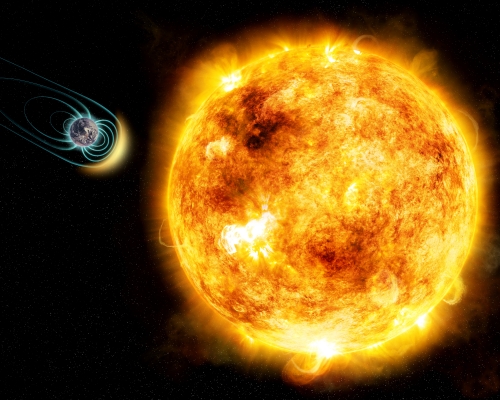
Image: In this artist’s illustration, the young Sun-like star Kappa Ceti is blotched with large starspots, a sign of its high level of magnetic activity. New research shows that its stellar wind is 50 times stronger than our Sun’s. As a result, any Earth-like planet would need a magnetic field in order to protect its atmosphere and be habitable. The physical sizes of the star and planet and distance between them are not to scale. M. Weiss/CfA.
The researchers used spectropolarimetric observations — measuring the optical properties of polarized light at different wavelengths — to analyze Kappa Ceti’s magnetic fields, combining these with models of stellar winds. Data were collected using a spectropolarimeter at the 2-meter Bernard Lyot Telescope (TBL) of Pic du Midi Observatory in the French Pyrenees.
Working with the magnetic properties of the young Earth and factoring in the strength of the young Sun’s plasma outflows allowed the team to estimate the size of the early Earth’s magnetosphere, which is found to be one-third to one-half as large as it is today. “The early Earth,” says do Nascimento, “didn’t have as much protection as it does now, but it had enough.”
The paper is do Nascimento et al., “Magnetic field and wind of Kappa Ceti: towards the planetary habitability of the young Sun when life arose on Earth,” accepted for publication at The Astrophysical Journal (preprint). A CfA news release is also available.

What Ceres’ Bright Spots Can Tell Us

Garrett P. Serviss was a writer whose name has been obscured by time, but in his day, which would be the late 19th and early 20th Century, he was esteemed as a popularizer of astronomy. He began with the New York Sun but went on to write fifteen books, eight of which focused on the field. He was also a science fiction author whose Edison’s Conquest of Mars (1898) used Wellsian ideas right out of War of the Worlds. It was a sequel to an earlier story, involving master inventor Thomas Edison in combat against the Martians both on the Martian surface and off it.
I think this is the first appearance of spacesuits in fiction. In any case, Serviss anticipates the ‘space opera’ to come, and will always have a place in the history of science fiction. I can only wonder what he would have made of the Dawn mission at Ceres. In Edison’s Conquest of Mars, he refers to a race of ‘Cerenites’ who are, because of the low gravity of their world, about forty feet tall. They are at war with the Martians, and thus allies of Earth.
Image: Author and science popularizer Garrett P. Serviss.
Forgive the digression, but I’m always interested in the work of people who bring science to the public, and it’s clear that Serviss’ interest in Ceres would have been profound, as works like Other Worlds: Their Nature, Possibilities and Habitability in the Light of the Latest Discoveries (1901) demonstrate. From Other Worlds, this look at Ceres and the asteroid belt as understood at the turn of the 20th Century:
The entire surface of the largest asteroid, Ceres, does not equal the republic of Mexico in area. But Ceres itself is gigantic in comparison with the vast majority of the asteroids, many of which, it is believed, do not exceed twenty miles in diameter, while there may be hundreds or thousands of others still smaller—ten miles, five miles, or perhaps only a few rods, in diameter!
Hundreds or thousands indeed. Another Serviss book, Astronomy with an Opera-glass (1888), holds up pretty well even today. Another thing I like about him is that in his science fiction, he writes scientists into the plot. Not just Edison, but Edward Emerson Barnard and Wilhelm Röntgen, to name but a few.
A New Look at Occator
But enough of early science fiction and on to Ceres today. Even before Dawn, we had made recent strides, nailing Ceres’ rotation rate, for example, by 2007, at 9.074170 hours. Those odd bright spots on the surface were evidently picked up in 2003 Hubble measurements, which showed a spot that moved with Ceres’ rotation, and water vapor plumes erupting from the surface have been reported using Herschel data, suggesting possible volcano ice geysers.
Now, of course, we’ve homed in on the bright spots in Ceres’ Occator crater, and the speculation about their origin continues. Are we looking at a relatively recent impact crater that has revealed bright water ice? Cryo-volcanism or icy geysers have also been suggested. As of today, we still don’t know whether the bright spots are made of ice, or evaporated salts, or some other material. A new study using the HARPS spectrograph at La Silla (Chile) has just appeared, showing us that whatever they are, the bright spots show changes over time.
Lead author Paolo Molaro (INAF-Trieste Astronomical Observatory) explains the method:
“As soon as the Dawn spacecraft revealed the mysterious bright spots on the surface of Ceres, I immediately thought of the possible measurable effects from Earth. As Ceres rotates the spots approach the Earth and then recede again, which affects the spectrum of the reflected sunlight arriving at Earth.”
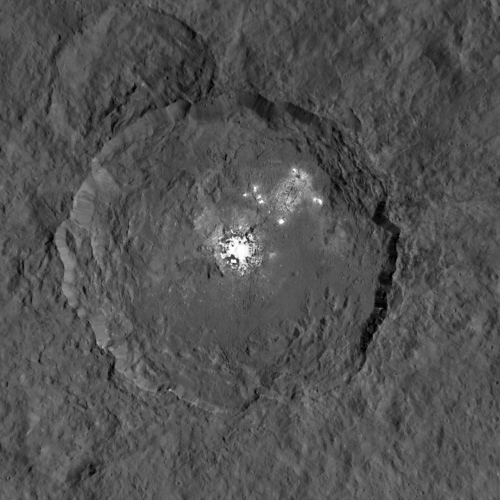
Image: The bright spots on Ceres imaged by the Dawn spacecraft.
The changes Molaro’s team has found are subtle — remember that nine-hour rotation rate, which means the motion of the spots toward and away from Earth is on the order of 20 kilometers per hour. But the Doppler shift caused by the motion can be revealed by an instrument as sensitive as HARPS. Over two nights of observation in July and August of 2015, the researchers found the spectrum changes they expected to see from this rotation, but they also recorded random variations from night to night that came as a surprise.
The paper lays out a possible cause: The bright spots could be providing atmosphere in this region of Ceres, which would confirm the earlier Herschel water vapor detection. Pointing toward this conclusion is the fact that the bright spots appear to fade by dusk, an indication that sunlight may play a significant role, possibly heating up ice just beneath the surface and causing the emergence of plumes:
It is possible to speculate that a volatile substance could evaporate from the inside and freezes when it reaches the surface in shade. When it arrives on the illuminated hemisphere, the patches may change quickly under the action of the solar radiation losing most of its reflectivity power when it is in the receding hemisphere. This could explain why we do not see an increase in positive radial velocities, but all the changes in the radial velocity curves are characterized by negative values. After being melted by the solar heat, the patches can form again during the four-hours-and-a-half duration of the night, but not exactly in the previous fashion, thus the RV curve varies from one rotation to the other. It is possible that the cycle of evaporation and freezing could last more than one rotational period and so the changes in the albedo which are responsible of the variations in the radial velocity.
As this ESO news release points out, the volatile substances evaporating under solar radiation could be freshly exposed water ice, or perhaps hydrated magnesium sulfates. The spots are brightest in the morning when their plume activity reflects sunlight effectively, but as they evaporate, the loss of reflectivity produces the changes analyzed in the HARPS data. We can add to the mix a recent paper in Nature (see below) that reports localized bright areas consistent with hydrated magnesium sulfates and probable sublimation of water ice.
So the mysterious bright spots of Ceres continue to tantalize us. As the paper notes, the fact that we find several bright spots in the same basin (Occator crater) seems to point to a volcano-like origin, but that would imply that an isolated dwarf planet can be thermodynamically active. Such activity is no surprise in large satellites around the gas giants, where tidal effects are assumed to play a major role, but its sources on Ceres will need further investigation.
The paper is Molaro et al., “Daily variability of Ceres’ Albedo detected by means of radial velocities changes of the reflected sunlight,” Monthly Notices of the Royal Astronomical Society Vol. 458, No. 1 (2016), L-54-L58 (abstract). The Nature paper is Natues et al., “Sublimation in bright spots on (1) Ceres,” Nature Vol. 528 (10 December 2015), 237-240 (abstract).

StarSearch: Our Hunt for a New Home World
His interest fired by an interview with interstellar researcher Greg Matloff, Dale Tarnowieski became fascinated with the human future in deep space. One result is the piece that follows, an essay that feeds directly into a recent wish of mine. I had been struck by how many people coming to Centauri Dreams are doing so for the first time, and thinking that I would like to run the occasional overview article placing the things we discuss here in a broader context. Dale’s essay does precisely this, looking at our future as a species on time frames that extend to the death of our planet. Dale retired in January 2015 from the position of assistant director of communications with New York City College of Technology/CUNY, a veteran journalist and editor of “Connections,” the college’s print and online magazine. He also did considerable writing for the New York City College of Technology Foundation and its annual Best of New York Award Dinner (and continues to do so on a freelance basis). Here he reminds us of the Sun’s fate and asks how — if we and our planet get through our technological infancy — we will find ways to move into the Solar System and, eventually, out into the Orion Arm.
By Dale Tarnowieski

Mother Earth – our home, sweet home – won’t be our home forever. In one billion years, give or take, increased heat from a steadily warming Sun will cause our planet’s temperatures to double, its oceans to boil away, and its land surfaces to turn to sand or melt. Assuming we’re still around, we’ll have to relocate before that happens.
A billion years is a long time off, so why the hurry to establish a foothold in space? One answer comes from astrophysicist Stephen Hawking, who warns that we may have as few as 200 years to establish permanent settlements on other worlds and begin mining our solar system for its bounty. Our numbers and the depletion of our planet’s finite resources are growing exponentially, as is our ability to alter the biosphere for good and ill. Within two centuries, Hawking contends, we could exhaust the resources available on Earth essential to our survival and damage our environment beyond repair.
But assuming we successfully respond to these more immediate challenges, the longer-term threat to our survival posed by a progressively warming Sun is one we won’t be able to avoid. We are already contemplating the use of mirrors in space to deflect sunlight as an anti-global warming measure as well as devices called space sunshades at neutral-gravity positions in the Earth-Sun system to reduce the increasing heat from our parent star. But such devices will do nothing to protect us when that heat becomes so intense that our only option will be to abandon our planet.
Now middle-aged, the Sun’s luminosity has increased 30 percent since its birth 4.6 billion years ago and will increase another 10 percent over the next one billion years. The radius of a more luminous Sun is projected to expand an estimated 200 times within four-to-five billion years and Mercury, Venus and possibly Earth and Mars will be vaporized.
Numerous natural or man-made catastrophes could bring most or all life on Earth to an end before the excessive heat from a warming Sun compels humankind’s relocation. But assuming no such catastrophe occurs, that move is only the first of two we’ll have to make. Several billion years later, it will be necessary to leave the solar system altogether as our dying Sun begins to swell.
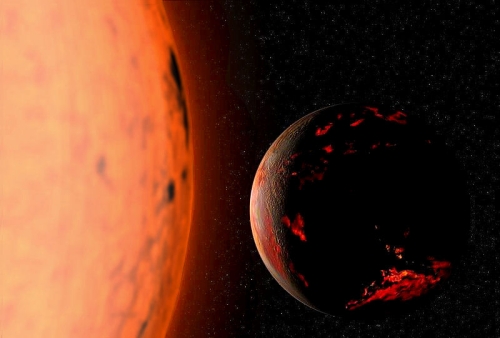
Image: A charred and glowing Earth of the far future, the Sun having long since entered its red giant phase. Credit: Wikimedia Commons CC BY-SA 3.0.
Holding Off the Inevitable
Could the abandonment of our world be avoided? In 2001, researchers Don Korycansky of the University of California-Santa Cruz, Gregory Laughlin of NASA and Fred Adams of the University of Michigan suggested that by maneuvering an asteroid 100 kilometers wide approximately 16,000 kilometers above Earth’s surface once every 6,000 years, we could slowly nudge our planet away from a more luminous Sun. But a collision with an object of such size would only have to happen once to prove catastrophic.
When our time on Earth runs out, the fortunate among us will join those already dwelling aboard orbital settlements circling more distant planets or their moons. Current thinking envisions others relocating to huge mobile in-space habitats called world ships or to open-air or enclosed settlements on Mars – the open-air variety depending on our successfully terraforming, or environmentally modifying, the biosphere of what at present is a frozen desert of a planet.
None of the other planets in our solar system is now remotely habitable. Closer to the Sun, a nearly atmosphere-free Mercury’s temperatures vary between -173 Celsius at night to +427 Celsius during the day. The latter is hot enough to melt lead. Venus is even hotter and possesses one of the deadliest atmospheres in the solar system. Farther from the Sun than Earth, Mars’s thin atmosphere is composed mostly of carbon dioxide and the planet’s weak gravity poses problems with respect to the retention of atmospheric gases. The four even more distant giants – Jupiter, Saturn, Uranus and Neptune – all have relatively small, dense cores surrounded by massive layers of gas. Jupiter and Saturn have thick atmospheres consisting primarily of hydrogen and helium, while Uranus is a world of liquid ice and Neptune home to wind speeds ten times those of the strongest hurricanes on Earth.
There are proposals for colonizing all of these worlds, including one that calls for the construction of an artificial surface together with its own life-supporting biosphere above the existing atmosphere of Jupiter. But among these proposals, the terraforming of Mars seems the most feasible based on current and anticipated technology.
Formation and Destiny of the Solar System
All stars are born and die, and our Sun is an ordinary yellow dwarf star born in a molecular cloud of dust and gas called a nebula. Consisting largely of hydrogen, the denser parts of that nebula underwent gravitational collapse and compressed to form a globule, or spinning ball of extremely hot gas, that later began to cool as a result of its emission of radiation.
As collapse progressed and the globule’s hydrogen atoms drew closer together, the temperature and pressure within that massive ball increased tremendously as did its rate of rotation. This increase in rotational speed also increased the resulting centrifugal force, causing the ball to form a pancake-shaped disk of stellar debris that extended far into space. This debris eventually coalesced through accretion into the four inner rocky and four outer gas or ice planets and other objects to which our solar system is home.
The four inner planets – Mercury, Venus, Earth and Mars – are called terrestrial worlds, which are smaller solid bodies made up of rock and metals with atmospheres of varying densities that were greatly modified early on by sunlight and the solar wind. The reason the four outer gas or ice giants are so much larger is that their greater distances from the Sun preserved, in part, their thick primeval atmospheres that condensed from the solar nebula.
When during the Sun’s formation the temperature of its core reached 15 million degrees Celsius, a process called nuclear fusion began, one sparked by the collision and binding of the core’s hydrogen atoms and their conversion by means of the intense heat produced into helium atoms, the second simplest and lightest of all the elements. This conversion created powerful outward forces of radiation pressure that eventually counteracted the force of inward gravitational collapse.
But as the Sun ages, the time will come when nuclear fusion will temporarily cease as our parent star begins to exhaust its supply of hydrogen and its helium content builds. This temporary cessation of nuclear fusion will briefly eliminate the resulting outward pressure and the Sun’s outer layers will fall inward on its core. This collapse will greatly increase the pressure on the core as well as its temperature, re-igniting the fusion of the Sun’s remaining hydrogen and triggering the fusion of its sizable accumulation of helium. The burning of helium will produce large amounts of carbon, which will act as a catalyst to increase 1,000-fold the rate of the fusion of the Sun’s remaining supply of hydrogen.
The greatly increased temperatures produced by this more intense fusion process will generate even more forceful outward pressure and the Sun will begin to swell enormously by pushing its outer layers deep into space. The movement of these layers away from the core will result in their gradual cooling. Less hot, they will appear less yellow and take on a reddish color as the Sun transforms into a red giant. Our parent star will grow increasingly unstable and release huge and violent bursts of solar material and heat. Because of its corresponding reduction in mass, the Sun’s gravitational sway will weaken and the orbits of the outer planets and other bodies spared incineration will change.
After eventually exhausting its nuclear fuel, the Sun will transform into a white dwarf star about the size of Earth. And theory has it that a very long time after that the Sun will become a cold and invisible dead star called a black dwarf. But the time required for a white dwarf to reach this stage is calculated to be longer than the current age of the universe and no black dwarf is believed to yet exist.
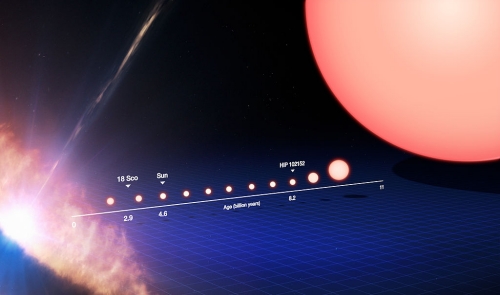
Image: This image tracks the life of a Sun-like star, from its birth on the left side of the frame to its evolution into a red giant star on the right. On the left the star is seen as a protostar, embedded within a dusty disc of material as it forms. It later becomes a star like our Sun. After spending the majority of its life in this stage, the star’s core begins to gradually heat up, the star expands and becomes redder until it transforms into a red giant. Following this stage, the star will push its outer layers into the surrounding space to form an object known as a planetary nebula, while the core of the star itself will cool into a small, dense remnant called a white dwarf star. The protostar stage, on the far left of this image, can be some 2000 times larger than our Sun. The red giant stage, on the far right of this image, can be some 100 times larger than the Sun. Credit: European Space Agency.
Humanity in the Far Future
Life has existed on Earth for 3.8 billion years, with the earliest examples of the human species thought by most anthropologists to have evolved in Africa about 300,000 years ago and anatomically modern examples 200,000 years later. The earliest fossil evidence of the precursors of the human species dates to between 1.9 and 2.4 million years ago.
Assuming our survival over the next one billion years, natural evolutionary processes will allow us to adapt for a while to changing environmental conditions as the Sun becomes more luminous. For example, skin color in humans might become uniformly dark. But we will experience increasing sensitivity to pressure changes as conditions worsen and horrific storms of enormous magnitude become routine and the time will come when we are unable to adapt further.
As conditions on Earth deteriorate, we may continue to dwell above ground in highly protective structures located away from our planet’s equatorial and temperate regions. Such enclaves will have their own energy-generating facilities and water and oxygen will have to be recycled.
But eventually, nearly all humans still living on Earth are likely to take refuge underground. In time, sub-surface or off-planet production of natural or synthetic foods will provide for all of humankind’s nutritional needs. And long before then, we will have moved to the full recycling of virtually all materials employed in the production of goods. Ground and air travel will be severely limited until such means of transportation become extremely problematic, and space elevators, rather than rocket-propelled vehicles, will transport people and materials to and from Earth orbit.
Toward Other Stars
The future exploration and settlement of nearby space beyond the Earth-Moon system will require many technological advances and innovations, including the use of solar system resources for propulsion systems that do not employ chemical propellants. For manned flights beyond the Moon, a generic in-space habitat module will need to be perfected. Shielding will need to be developed to reduce crew exposure to galactic cosmic rays and solar flares and solar flare warning time will need to be increased. Some type of landing vehicle, surface habitat and an enhanced space food system will have to be developed for missions to Mars and beyond.
Also required will be the development of technologies that enable us to explore the near-interstellar environment. First, advanced robotic probes will visit the heliopause at about 200 Astronomical Units or AUs, where one AU is the mean distance between Earth and the Sun. Later missions will explore the Sun’s inner gravitational focus at 550 AUs and finally the inner reaches of the Sun’s Oort Cloud at 1,000 AUs.
Much later, faster and even more advanced robotic probes will fly through neighboring star systems with potentially habitable planets. These will be followed by probes that will decelerate in selected planetary systems and dispatch landing craft to the surfaces of suitable planets in the habitable zones of targeted stars. Full computer management of these missions will be necessary, because even speed-of-light communications over such vast stretches of space will preclude real-time oversight by humans located in our solar system.
While nearly all of today’s rockets are fueled by chemical propellants, future spacecraft operating within our solar system are likely to be propelled by either the Sun or nuclear fission or fusion, which would greatly reduce travel times to Mars and beyond. Current thinking calls for spacecraft venturing beyond our solar system to be propelled by some type of fusion reaction or a light sail, although an antimatter propulsion system and electric sailing on the solar wind are other possibilities. Moreover, new systems of deceleration at journey’s end will need to be developed.
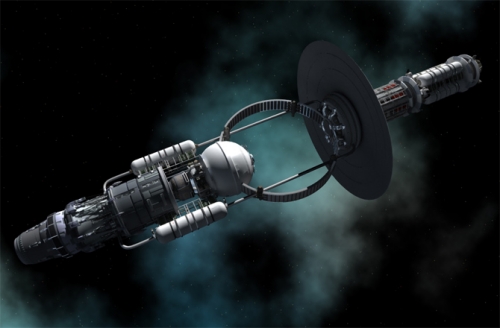
Image: About as futuristic as it gets, this is a design visualization of a black hole augmented interstellar ramjet concept developed by Kelvin Long for the Initiative for Interstellar Studies. Credit: Adrian Mann.
The two principal dangers to humans in the manned exploration of space are cosmic rays and microgravity. Too large a flux of cosmic rays can result in cancer or mental degradation. Long-term exposure to microgravity can cause muscle and bone deterioration.
If a craft is moving rapidly, the induced cosmic ray flux caused by impacting interstellar ions and atoms could be alleviated by thick shields in front of the habitat section. A combination of thick shields and magnetic fields around the habitat would greatly reduce the flux of galactic cosmic rays. Microgravity effects could be reduced by spinning a ship in order to produce fractional Earth gravity on the inner rim.
If a craft is moving at a higher fraction of the speed of light, one problem is occasional impacts by cosmic dust particles. A shield in front of the craft or a combination of particle-detecting radar and particle-zapping lasers could alleviate this problem. If the ship must make a close solar pass, special care must be taken to protect crew and equipment from high-energy solar photons and solar winds.
Even close to home, spacecraft might be impacted by cosmic rays produced by a distant exploding star, or supernova. To protect the crew, a shield could be attached to the habitat to block the cosmic ray flux from the supernova. Since gamma rays are neutrally charged high-energy electromagnetic photons, mass shielding rather than magnetic fields would be necessary.
The dangers inherent in cosmic rays might be alleviated on manned trips to Mars through a method of travel described in a March-April 2011 Acta Astronautica article, “NEOs as stepping stones to Mars and main-belt asteroids,” by Gregory Matloff and Monika Wilga. This method makes use of space resources located not far from Earth – those small asteroids or comets known as “Near-Earth Objects” or NEOs. The article calls this form of travel “NEO hitchhiking.”
Most of those celestial icebergs we call comets reside in two locations far from the Sun in the distant Kuiper Belt and Oort Cloud, while most of the rocky and stony minor planets or asteroids are located in the Asteroid Belt between Mars and Jupiter. In recent decades, however, increasing numbers of extinct comet and asteroid-like objects have been observed in orbits that bring them close to Earth.
Following Earth escape, a velocity change would be applied to a human-piloted spacecraft bound for Mars, a change that allowed the craft to rendezvous with a NEO two to three months later. During the balance of the interplanetary flight and after the crew imbedded the craft within the NEO, the latter’s material would be used to shield the craft from cosmic rays.
While during any ship’s return voyage a similar strategy would be followed, various mission proposals suggest that diverse contingents of space travelers sent to Mars, for example, should expect to stay and never to return to Earth. Such one-way missions could be accomplished with less difficulty and at less cost. Their crews would establish settlements that would expand as additional travelers followed and those already there reproduced.
Terraforming a Close Neighbor
The terraforming and colonization of Mars – the only other planet in our solar system where environmental modification now seems feasible – are not absolutely essential to humankind’s survival. But the successful terraforming of that world could make possible a reasonable facsimile of an Earth-like existence for a sizable population. While much of the work of terraforming Mars would be done by robots, humans overseeing this effort would be largely confined to underground habitats perhaps built into extinct lava tubes to protect them from galactic cosmic rays. However, technological advances in high-temperature superconductors might enable the construction of giant artificial magnetic shields to insulate all early settlements and allow their Earth-normal inhabitants to reside above ground and shed protective gear as long as they remained within the shielded environments.
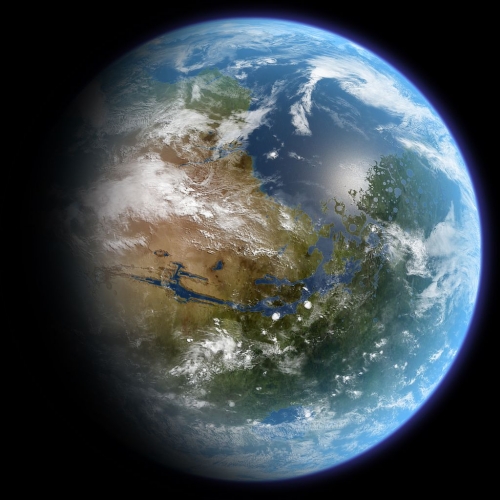
Image: An artist’s impression of a terraformed Mars centered over Valles Marineris. The Tharsis region can be seen of the left side of the globe. Credit: Daein Ballard/Wikimedia Commons CC BY-SA 3.0.
Terraforming Mars would take a very long time and unfold in stages. The most distant from the Sun of the four terrestrial planets, Mars’s thin atmosphere is composed mostly of carbon dioxide. Its polar ice caps consist of a top layer of frozen carbon dioxide and a lower layer of water ice, and scattered elsewhere across areas of the planet are subsurface pockets of permafrost.
Evidence suggests that Mars once was home to at least one sizable ocean and that rivers of liquid water streamed across the planet’s surface and may exist underground today. More recent findings indicate that small streams of liquid water appear to flow on the surface during the planet’s warmer months. But steps could be taken to alter the trajectories of icy celestial objects to impact Mars at low velocities and deliver much of the water needed to create the vast reservoirs that would be critical to environmentally modifying that world. However, maintaining such liquid water reserves would first necessitate increasing the planet’s temperature and thickening its atmosphere.
In-space mirrors could be used to reflect additional sunlight on the planet and impacts by other celestial object could be engineered to help create a greenhouse effect that would warm the planet’s atmosphere and deliver the ammonia that would enable its nitrogen enrichment. Mars’s high carbon dioxide levels also could be utilized to help thicken its atmosphere.
Next, techniques could be employed to electrolyze some of the liquid water in the eventually created Martian seas. This would help produce the level of atmospheric oxygen required to sustain human as well as other Earth-indigenous animal life. What’s more, the process of passing an electrical current through water could be used to separate its hydrogen and oxygen components. Transformed into their separate gaseous states and then recombined in a combustion chamber, these components could serve to create energy for all types of uses.
After creating conditions to better retain atmospheric and surface heat, sections of Martian soil could be chemically and biologically treated and Earth-indigenous flora introduced to help produce even more atmospheric oxygen. However, it would be necessary to continuously work at enriching the oxygen content of the Martian atmosphere because of the planet’s weaker gravity, which poses special problems with respect to the escape time of gases.
In addition, Mars’s orbit around the Sun is more elliptical than Earth’s. It lacks a large satellite like Earth’s Moon and it is closer to giant Jupiter. These factors contribute to a periodic shift in the tilt of Mars’s axis, resulting in a destabilization of the Martian atmospheric composition, temperature and other environmental factors. Periodic corrective adjustments would be required.
Mars has half the radius of Earth and only one-tenth the mass, making the surface gravity on that world less than 40 percent of that on Earth. It has yet to be determined whether this level of gravity is sufficient to prevent the various health problems associated with weightlessness and how we would deal with these problems.
Surviving on an environmentally modified Mars could require genetic modifications to our species and other Earth-indigenous animal life forms. Genetically reengineered back on Earth, lower animal life forms would be introduced first and genetically modified humans later on. Modified humans and other animals might have larger eyes able to better function in an environment marked by reduced light from a more distant Sun. In addition, genetic alterations would be required for animal life to withstand higher levels of cosmic radiation in view of the fact that Mars lacks a substantial magnetic field to deflect incoming rays.
While many of our distant descendants will probably call Mars home, either below or possibly on the surface or aboard huge orbiting settlements, what will existence be like for others residing on the mobile world ships mentioned earlier? Such in-space habitats are likely to be of cylindrical or spherical shape, measure from less than one to as many as 10 kilometers in length or diameter and rotate around an axis so that their passengers on the inner rim can experience an analog of Earth-normal gravitation. If not as luxurious as those depicted in Hollywood’s fictional starships, the interior environments of these habitats will be comfortable enough. But tighter living quarters on the world ships could result in increased stress-related interpersonal issues among crew and passengers. Such ships will likely be totally recycling or resupplied using in-space resources, with only luxury items imported from Earth. Work is already underway to develop seeds that can grow into edible vegetables in only a few days and applications of 3D printing and more advanced technologies may one day enable the production of animal and other types of food products.
Destinations in the Galaxy
With the search for a new home world in interstellar space already underway, what kind of planet are we looking for and where do we expect to find it? Within our Milky Way Galaxy, there is a relatively narrow region called the galactic zone of life where life as we know could survive. Earth-like life could not survive in star systems located too close to the extremely dense and highly radioactive center of the galaxy, to dense star-forming regions with their high levels of radiation located elsewhere, or in regions in which certain higher elements are absent or in short supply. Moreover, the habitable zones surrounding individual stars in which Earth-like life could survive are also relatively narrow, and various factors would have to come into play in relation to suitable planetary bodies located within such zones to make them suitable for migration.
In interstellar space, we’re searching for planets of roughly Earth surface gravity located in the habitable zones of stable main sequence stars. Ideally, those planets will have day-night cycles similar to Earth’s and enough atmospheric oxygen to enable us to breathe, but not so much that combustion is uncontrolled. The average temperature on at least parts of the surfaces of those planets will have to be between the freezing and boiling points of water, which will have to be present on those worlds for humans and other terrestrial life forms to survive. Any life forms indigenous to those worlds should be more or less compatible with terrestrial life and not overly hostile. If indigenous DNA and proteins are similar to the varieties found on Earth today, virulent germs should be no more prevalent than here.
A cosmic event that could impact our interstellar migration involves the anticipated merger in four billion years or so of the Milky Way and Andromeda Galaxies. The two are part of a larger family of galaxies known as the Local Group, and the interplay of gravitational forces is expected to reconfigure them into a more massive galaxy elliptical in shape. Some models show the two merged galaxies absorbing the Triangulum Galaxy a few billion years later. While collisions between individual stars are expected to be rare, the stars in the merging galaxies will be thrown into different orbits around a new galactic center. There are many questions concerning how this reconfiguration might affect the timing and other aspects of our relocation from a dying solar system to a new home world orbiting another star.
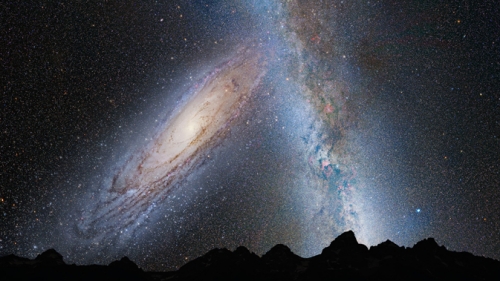
Image: This illustration shows a stage in the predicted merger between our Milky Way galaxy and the neighboring Andromeda galaxy, as it will unfold over the next several billion years. In this image, representing Earth’s night sky in 3.75 billion years, Andromeda (left) fills the field of view and begins to distort the Milky Way with tidal pull. Credit: NASA; ESA; Z. Levay and R. van der Marel, STScI; T. Hallas; and A. Mellinger.
Emergence of Artificial Intelligence
The survival of the human species and other life forms indigenous to Earth will require the development of the technologies described throughout this narrative and the non-occurrence of some natural or man-made disaster severe enough to end all or most life on Earth before a more luminous Sun forces us to abandon our home planet. Our relocation is expected to first take us to the deeper reaches of our solar system, while computer-controlled robotic entities search for and then make ready for human habitation at least one new home world orbiting another star. And when our Sun begins to die, our survival will require that ships crewed by robots transport to that world the building blocks of human and other life forms for subsequent harvesting.
While it’s a stretch, at present, to envision humans ever traveling to the stars as functioning living beings because of the enormous distances involved, doing so in a state of suspended animation has been proposed. Suspended animation involves the slowing of life processes by external means without their termination. But the relocation of a sizable number of humans, either as functioning beings or in inanimate states aboard sleeper ships, could require many craft of considerable size, while a lesser number of ships of smaller size carrying the bio-diverse genetic building blocks of life could accomplish the same objective.
Barring the development of faster-than-light warp drive, the actualization of relativity theory wormhole short-cuts through space-time, or other currently theoretical applications of physics and engineering, the interstellar transport and later harvesting of the biological building blocks of human and other Earth-indigenous life forms would be the work of robotic entities, with oversight provided by a supercomputer capable of highly sophisticated cognitive computing.
But the time is not far off when “technological singularity” will make possible levels of artificial intelligence that are expected to surpass that possessed by today’s smartest human beings and most advanced computers – a time beyond which the course of animate human history becomes highly unpredictable. Might such levels of artificial intelligence decide to do away with animate humans because of their inability to keep pace with them? In that case, there will be no transporting of the biological building blocks of humankind to another star system.
Another idea envisions the eventual uploading of the human essence to computers. When the organic brains of humans begin to die, consciousness and memory would transfer to memory implants. The content of these implants would be input into a computational device and exist forever in some future equivalent of the virtual world. What would relocate to another star system would be the device and its contents, not human beings themselves.

Image: A human future among the stars may depend upon artificial intelligence we create. Credit: RAND Corporation.
But assuming that the interstellar transport and eventual harvesting of the biological building blocks of humankind by robots is what occurs, we can think of those robotic agents as electromechanical nannies charged with responding in nurturing ways to an infant or young child’s physical, intellectual and emotional needs and overseeing many of the complex requirements essential to a child’s early development and education. The supercomputer and robots that will be required to oversee all aspects of this transport and harvesting will need to possess capabilities that far exceed what is possible today.
The successful socialization of the first generation of humans harvested on some distant world would best be served by benign, non-living yet sentient-like robots called androids that simulate adult humans in appearance, behavior and speech. With the development of such entities already in progress, such computer-controlled machines will eventually possess human-like abilities to see, hear, taste, smell and touch.
The long-term survival of our species will require the development and intelligent use of innovative space propulsion systems, robotics, genetics, computers and information technology designed to spread terrestrial life beyond Earth and our solar system. While most of what has been discussed in this narrative lies in the distant future, it is a wondrous adventure upon which we have already embarked.
——-
The author greatly appreciates the extensive scientific and technical guidance provided by Gregory L. Matloff, PhD.

Agriculture on Other Worlds
Because Centauri Dreams focuses on the outer system and beyond, I haven’t had much to say about Mars, knowing how many good sites there are that cover developments there. But today’s post is timely not only because of recent depictions of Mars in film but also because long-term sustainability is critical to a lasting human presence off-world. Dr. Ioannis Kokkinidis is a native of Piraeus, Greece. He graduated with a Master of Science in Agricultural Engineering from the Department of Natural Resources Management and Agricultural Engineering of the Agricultural University of Athens. He holds a Mastère Spécialisé Systèmes d’informations localisées pour l’aménagement des territoires (SILAT) from AgroParisTech and AgroMontpellier and a PhD in Geospatial and Environmental Analysis from Virginia Tech. Have a look now at what we could do to sustain a human settlement on another world.
By Ioannis Kokkinidis

I believe most readers of this blog have seen Ridley Scott’s The Martian and perhaps have even read Andy Weir’s book. Our hero Mark Watney is stranded on Mars and has to overcome a series of crises in order to survive, including growing food. Entertainment aside, the question of how could we grow crops on other worlds is a serious one. As an agronomist, a practitioner of the scientific discipline that conducts analysis and experiments so as to offer advice to farmers, I offer here my take on the subject.
The issue of growing food on other worlds seems to be generally neglected in science fiction. It tends to be brushed over through the use of replicators, miraculously processed food that turns into a scrumptious meal with a few drops of water or other similar plot devices. Until these devices are invented it is better to speculate using existing technology. The majority of the suburban and urban populations are not aware of modern agricultural practices, having a mental image of a rural utopia that reflects decades or centuries past.
Also, farming practices in each country tend to reflect its socioeconomic conditions and level of development: the best method to grow food in the confined and limited space of a colony is often not the one practiced by farms near where you live. For this article I will give a special emphasis on Mars, because our knowledge of the planet is better than that of other heavenly bodies and because of its relative suitability compared to other worlds. This article is divided into two parts dealing with plant and animal production.
Plant Production
Plants require some 30 or so elements to grow. C, H, O, N, P and K are required in large quantities and are called macronutrients, Fe is an intermediate case and the rest are called micronutrients, required in minuscule quantities. Carbon is absorbed from the atmosphere in the form of CO2. Hydrogen is absorbed through the roots in the form of water. Oxygen enters through CO2 and H2O, while the rest of the elements are absorbed through the roots dissolved in the liquid solution. A common misconception about plants is that soil is necessary for their growth: it is not. What is necessary is a liquid solution containing the necessary elements to grow. The practice of growing plants in a soil-less medium is known as hydroponics and was the subject of my undergraduate thesis, which I conducted in Portugal as an Erasmus student. The very specific case where instead of a medium the root is suspended in midair, with the solution sprayed to the root, is called aeroponics.
Hydroponics dates to plant nutrition experiments in the late 19th century. The first major applications appeared during WWII when it was used to grow fresh food by the United States armed forces in the Pacific for garrisons in bare islands that were too isolated for effective resupply. Commercially it was first used in the Netherlands during the 1960’s in greenhouses, where after decades of using the same soil there were too many disease vectors for use. Over the decades it has become a relatively popular method to grow crops in greenhouses, preferably in places that are densely populated and have significant available capital. While all crops can be grown hydroponically, commercially it is limited to high value crops such as vegetables and flowers: Field crops receive free ecosystem services from the environment; in a hydroponic greenhouse we need to provide and/or supplement them artificially.
Plants convert radiation into biomass through photosynthesis. In lower plants such as blue green algae this biomass is in the form of undifferentiated cells. In higher plants there are differentiated organs such as tubers, fruits, stems and leafs. While algae is consumed whole after treatment, we often consume parts of plants, the specific part depending on the species.
Furthermore, there is no such thing as a superplant able to provide the entire needs of human nutrition on its own. We will need to grow a mix of species to provide the various needs of the colonists. A major problem though is that we do not know what the actual nutritional needs of the colonists will be. An office worker on Earth needs 2000-2500 calories per day; a manual laborer can easily consume over 5000. We do not know what the effect of lower gravity is in caloric consumption or the relative requirement on each food component. However, there have been various studies proposing crops mixes for future colonies.
I envision the future Mars plant growth facility as a greenhouse. Since Martian surface pressure is very close to a vacuum, this greenhouse will need to be a pressure vessel. The closest thing yet constructed to a high transmittance pressure vessel is the ISS Cupola. The alternative option is to build a completely enclosed facility with artificial illumination. I am more in favor of a facility with windows, as the inside of a greenhouse is a very corrosive environment and in my opinion it is better to have the option of the sun than to be completely reliant on artificial light sources. That being said, at Mars levels light intensity is lower than that of Earth on clear days, though pretty similar to cloudy days in Northern Europe. In Northern Europe the lack of solar illumination is compensated through supplementary artificial lighting. In my native Greece light intensity is such that farmers will actually put stucco on their greenhouse’s covering material in late spring so as to reduce illumination and the solar heating it causes. This is unlikely to be necessary on Mars.
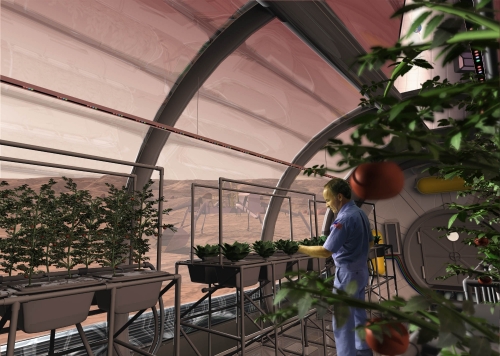
Image: An artist concept depicts a greenhouse on the surface of Mars. Credit: NASA.
Cover materials for greenhouses on Earth tend to fall into three categories: PET, glass and clear PVC. PET (polyethylene terephthalate) is the most popular material because of its low cost and the light greenhouse structure it requires. It comes in various quality levels, ranging from a thin flexible material that lasts only one season until it is yellowed by UV radiation to relatively thick panels that are rated to last 10 years and in practice can last a bit longer. PET is susceptible to yellowing due to UV radiation and is completely clear to IR radiation. Glass is material that is bristle, easy to break but is known to last for centuries so long it is cleaned. Due to its fragility it requires a heavier structure greenhouse. Clear PVC (polyvinyl chloride) combines the lightness of PET with the longevity of glass. Unfortunately it is a very expensive material, making its uses on Earth rather rare. While I am unaware of any experiment to test long term survival of greenhouse cover material under simulated Martian conditions, my educated guess would be that clear PVC would be the best option for a Martian cover material.
The inside of a high end modern greenhouse contains quite a bit of machinery. Artificial lighting has been mentioned, which will be necessary not only for increasing radiation but also in order to control day length: many temperate species will not set flowers and fruit unless a specific day or night length is met. This phenomenon is known as photoperiodism. On the flip side, the greenhouse will also require a shade to extend night length. In order to reduce heat losses during the night we will most likely need a thermal blanket.
Now in Athens from March on, on a sunny day the temperature inside a greenhouse can reach 40° C. This is not a tolerable temperature for most plants, which is why we keep the doors and windows open on a greenhouse from 10-11 am up to sunset. On Mars of course that is impossible, so should this problem arise we will need a system to remove heat during the day.
We will also need a system to add heat during the night, which even on the Martian equator in the summer can be lower than Earth’s Polar Regions. While on Earth we can rely on ambient air to introduce the CO2 which is removed by the plants, on Mars we will need to provide it. A greenhouse full of mature plants can assimilate the entirety of its atmospheric CO2 within a couple of hours from sunrise. Putting CO2 in excess of atmospheric concentration is a known method to accelerate the life cycle and increase yield in plants, called carbon fertilization.
Usually CO2 is pumped to the 1500 ppm level around sunrise, and the plants will often assimilate this by noon. Since workers often need to enter the greenhouse to work they will do so around the time CO2 drops below ambient concentration so as to bring new atmospheric CO2 in the facility. The Martian atmosphere is fortunately 96% CO2, however higher plants do not usually tolerate more than 4% concentration. Algae can survive up to 70% concentration, which is why it has been used for carbon sequestration in power plants on earth. CO can also be a problem for workers though not for the plants; they can oxidize it to CO2 and assimilate it. In general plants act as water pumps, carrying water from their roots and releasing it in their leaves. On earth we lower humidity by exchanging air, for Mars we will need to do so through machinery. We will need, though, pumps of the mechanical kind to circulate the irrigation water.
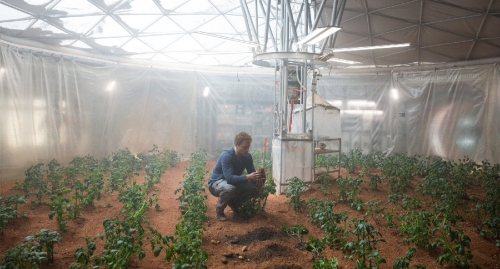
Image: From The Martian, astronaut Mark Watney (Matt Damon) works inside a flourishing greenhouse. Credit: Twentieth Century Fox Film Corporation.
Over the last few decades agronomists and farmers have tested a variety of substrates for hydroponic use and have almost always found the material suitable. There is no reason to believe Martian regolith will not be found suitable as substrate, but it would be better for the first colonists to also bring from Earth material proven to work, such as rockwool or cocopeat. While we’ll have a few plant rows working with the proven material, we will have a few experimental rows trying to discover the best methods for the regolith.
As mentioned, hydroponics plants require a nutrient solution to provide their needs. There are two types of nutrient systems available: open loop (also known as run to waste) where the solution is dumped after it passes once through the row, and closed loop, which still dumps about 20% of the solution after loop. Although we will most likely require a N fertilizer production facility anyway, since we will be dealing with limited resources, it is better to adopt a closed loop system despite the issues this creates with plant protection. In a hydroponic greenhouse the solution for each of the elements is produced in large vats where the worker mixes each fertilizer with water. The automation pumps each solution in a new vat where it is mixed to contain the element mixture we wish and pH is regulated using acid or base. Then it is sent to each row for plants to use. Plants selectively assimilate each element depending on the soil and water pH; often element deficiencies are caused not due to lack of the element in the solution but by the inability to assimilate it at the solution’s pH or competition with other elements.
Another phenomenon typical in regions with bad quality water such as Cyprus is precipitation of the micronutrients as a sediment that can block the water emitters. Future Mark Watneys will have their day full just trying to bring their crop into production.
Another issue that future Mark Watneys will need to face is plant protection. Crops on earth get attacked by a variety of pests and diseases. Much as we can try to keep an aseptic environment on Mars, this is likely to happen eventually. We have no idea what the interaction between potential indigenous Martian lifeforms and our plants could be. What we do know, though, is that it is very likely we will bring pests from Earth; already Scott Kelly had to combat a mold on the Veggie experiment on the ISS. By controlling humidity and temperature we can control the growth of pests. However, for major infestations we will likely need to use chemicals and this raises all sort of issues. For one thing we are talking about complicated molecules which we will either need to ship from Earth or synthesize locally. Also, we will need to make sure that they do not enter the air of the human habitat. The best line of defense, though, is polyculture, growing a variety of crops. If one particular crop fails, there will be food from the rest.
Photosynthesis is not the only way to grow food; we can grow calories from decomposition of plant material. Pleurotus mushrooms are an easy way to turn hay into high quality nutrition. All that is required is hay and a dark room without any sunlight. The hay stack (which could be the stem of the plants grown) is inoculated with mushroom spores, placed in a cubic plastic tarp with slits and we harvest every week the growth coming out of the slits. In the end we have both high quality nutrition and a material which can be used for compost at the mushroom’s roots. Soil compost, which we can also create with other biological materials in the habitat will help detoxify soil and thus move towards soil based agriculture on Mars.
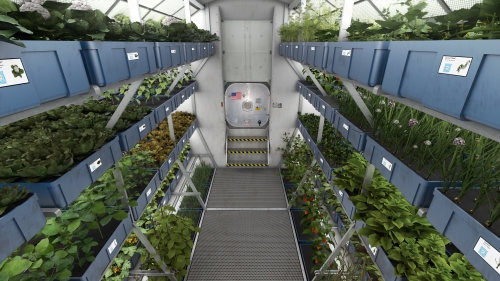
Image: NASA plans to grow food on future spacecraft and on other planets as a food supplement for astronauts. Fresh food, such as vegetables, provide essential vitamins and nutrients that will help enable sustainable deep space pioneering. Credits: NASA.
Animal production
A completely vegan diet cannot easily provide all the necessary nutrients for survival in the long term. While at first we can expect animal derived products to arrive with resupply missions, in the long term we will need to engage in animal production to meet the needs of the colony. Meat is an integral part of the Western diet; however, the availability of cheap food mostly reflects the large grazing ground of the US West or the Argentinian Pampas and the policies of the EU Common Agricultural Policy. Growing animals off Earth will mean adopting the model of the Concentrated Animal Feeding Operation (CAFO) rather than low intensity pastoral agriculture.
The most important number in a CAFO is the feed conversion ratio (FCR). It is defined as the quantity of animal feed required to produce one kilogram of body mass. It varies by species, facility, feed composition, climate, age of the animal and production facility. Wikipedia has an interesting article on the subject. FCR ranges from under 2 for crickets, tilapia and some chicken facilities, around 3 for pigs and rabbits, and at least 4 for sheep and cattle.
Now, to achieve these high numbers requires optimized genetic stock, optimized feed and optimized environmental conditions. Modern efficient chicken farms require the use of high yield chicken hybrids that are provided as week old hatchlings to the CAFO. There they are kept in temperature controlled facilities, often in cages with 6 animals per cage. Feed is constituted of high yield grains which must meet specific food group mixture ratios and often includes antibiotics in sub-therapeutic concentrations so as to increase FCR. After 7-8 weeks, when the animals are immature sexually but have reached the expected weight they are harvested and sent to the slaughterhouse.
Losses of 5-10% of the original animal population are typical. Simply put, it requires a very large infrastructure with large breeding flocks so as to minimize the possibility of incest (and the drop in FCR it brings) just to provide these hatchlings. Another thing to note is that we do not eat whole animals or fishes, only part of them. Typically the commercial cuts of the animal are in the order of 50-55% of the body mass. In other words animal production is very inefficient. However, there are a few advantages to animal production. For one thing, we do not eat the entirety of the cultivated plant. Traditionally animals consume first what people do not.
Assuming a Harvest Index of 1, typical for small grains, producing 1 kg of grains will also produce 1 kg of above ground biomass, mostly the plant stem. With a feed conversion ratio of 3 this will convert to 333 g of animal. With a commercial cut ratio of 51% this means that 170 grams of meat can be produced along with 1 kg of grains. In practice an FCR of 3 is unrealistic for any animal only fed on hay and we are likely to lose animals during production. Still, we can presume the possibility of a diet composed of 10% meat by weight in the long term of the colony without significant dedicated plant growth for feed.
If we wish to have 50% of meat in our diet by Mars-grown animals, this means that with an FCR of 3 and an edible weight ratio of 0.5 and assuming that the stem is not used for the feed, we will require 3.5 times the growth area in the farm than for a 100% vegan diet. This is on top of the necessary veterinary support for the animals or the need to manage animal wastes of all kinds. Furthermore, while we can select plant varieties that are parthenocarpic and/or self-pollinated, animals only reproduce sexually, which means that we will need to maintain a flock of sufficient genetic diversity.
Conclusion
This essay has tried to deal with some of the issues that come with growing food away from earth in a gravity environment, with an emphasis on Mars, from the perspective of an agronomist. Several of the concepts can be used in other worlds too, though it will require coming up with sources of carbon dioxide and photosynthetic radiation which are available on Mars. The MIT study of the Mars One concept mission came to the conclusion that the space allocated in the concept (80 m2 per colonist) was insufficient to provide enough calories for the colonists, while increasing to a more realistic 250 m2 led to oxygen poisoning around the time the plants were in full bloom. Bas Lansdorp replied that his plan was to use an oxygen concentrator to remove the excess oxygen from the growth facility.
There have been comments that the model that MIT used to calculate the production of oxygen overestimated how much is actually produced. As an agronomist, though, I am inclined to believe that even if that particular model has bugs, the consumption of the entire CO2 of the habitat in a day by photosynthesis in a greenhouse housing plants in the full growth stage is consistent with earth behavior of greenhouses. With this article I try to highlight for potential planners, engineers and enthusiasts the kind of issues that will realistically be encountered when designing a food growth system for a small closed colony.

